Page 2754 of 4264
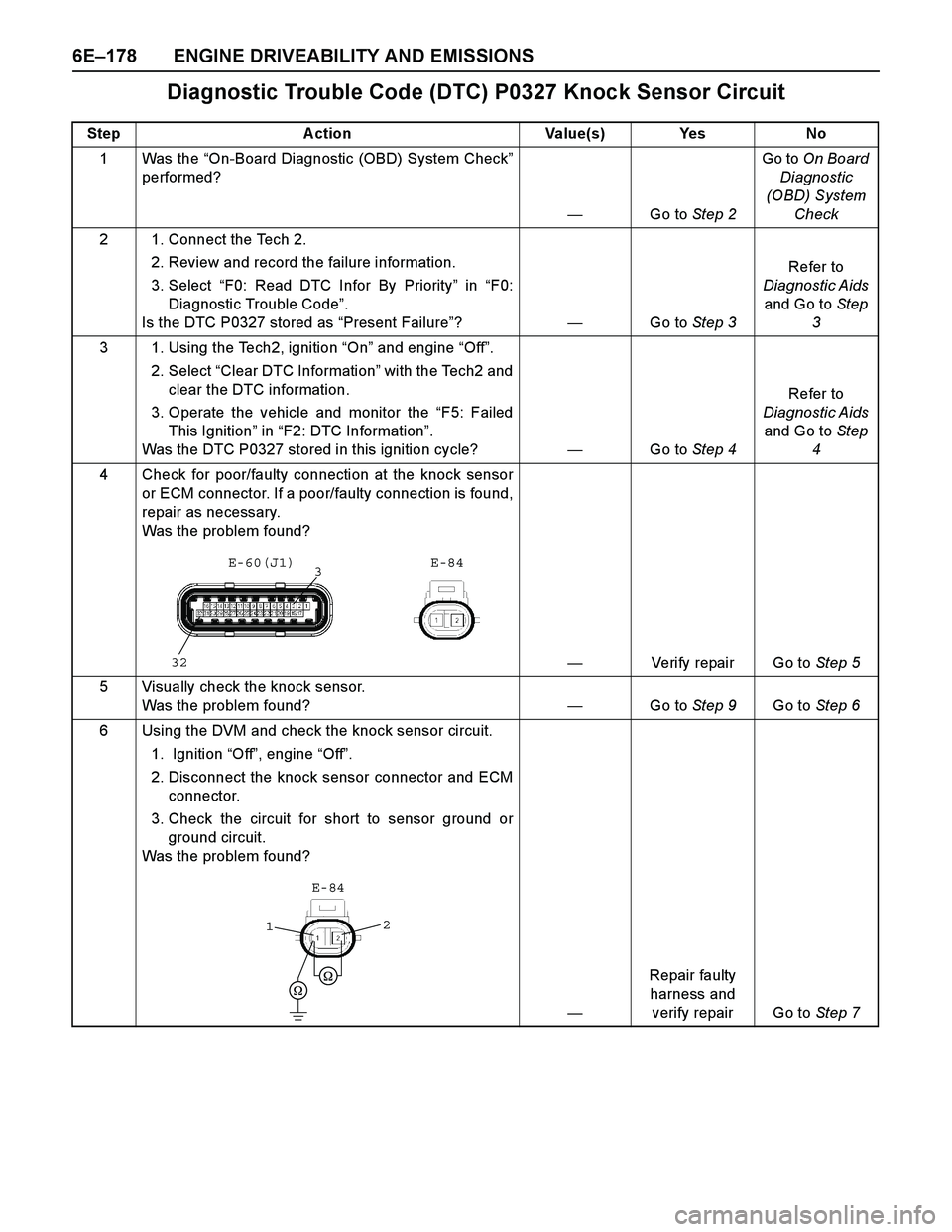
6E–178 ENGINE DRIVEABILITY AND EMISSIONS
Diagnostic Trouble Code (DTC) P0327 Knock Sensor Circuit
Step A ction Value(s) Yes No
1 Was the “On-Board Diagnostic (OBD) System Check”
performed?
—Go to Step 2Go to On Board
Diagnostic
(OBD) System
Check
2 1. Connect the Tech 2.
2. Review and record the failure information.
3. Select “F0: Read DTC Infor By Priority” in “F0:
Diagnostic Trouble Code”.
Is the DTC P0327 stored as “Present Failure”?—Go to Step 3Refer to
Diagnostic Aids
and Go to Step
3
3 1. Using the Tech2, ignition “On” and engine “Off”.
2. Select “Clear DTC Information” with the Tech2 and
clear the DTC information.
3. Operate the vehicle and monitor the “F5: Failed
This Ignition” in “F2: DTC Information”.
Was the DTC P0327 stored in this ignition cycle?—Go to Step 4Refer to
Diagnostic Aids
and Go to Step
4
4 Check for poor/faulty connection at the knock sensor
or ECM connector. If a poor/faulty connection is found,
repair as necessary.
Was the problem found?
—Verify repair Go to Step 5
5 Visually check the knock sensor.
Was the problem found? —Go to Step 9Go to Step 6
6 Using the DVM and check the knock sensor circuit.
1. Ignition “Off”, engine “Off”.
2. Disconnect the knock sensor connector and ECM
connector.
3. Check the circuit for short to sensor ground or
ground circuit.
Was the problem found?
—Repair faulty
harness and
verify repair Go to Step 7
32
3 E-60(J1) E-84
E-84
2
1
Page 2755 of 4264
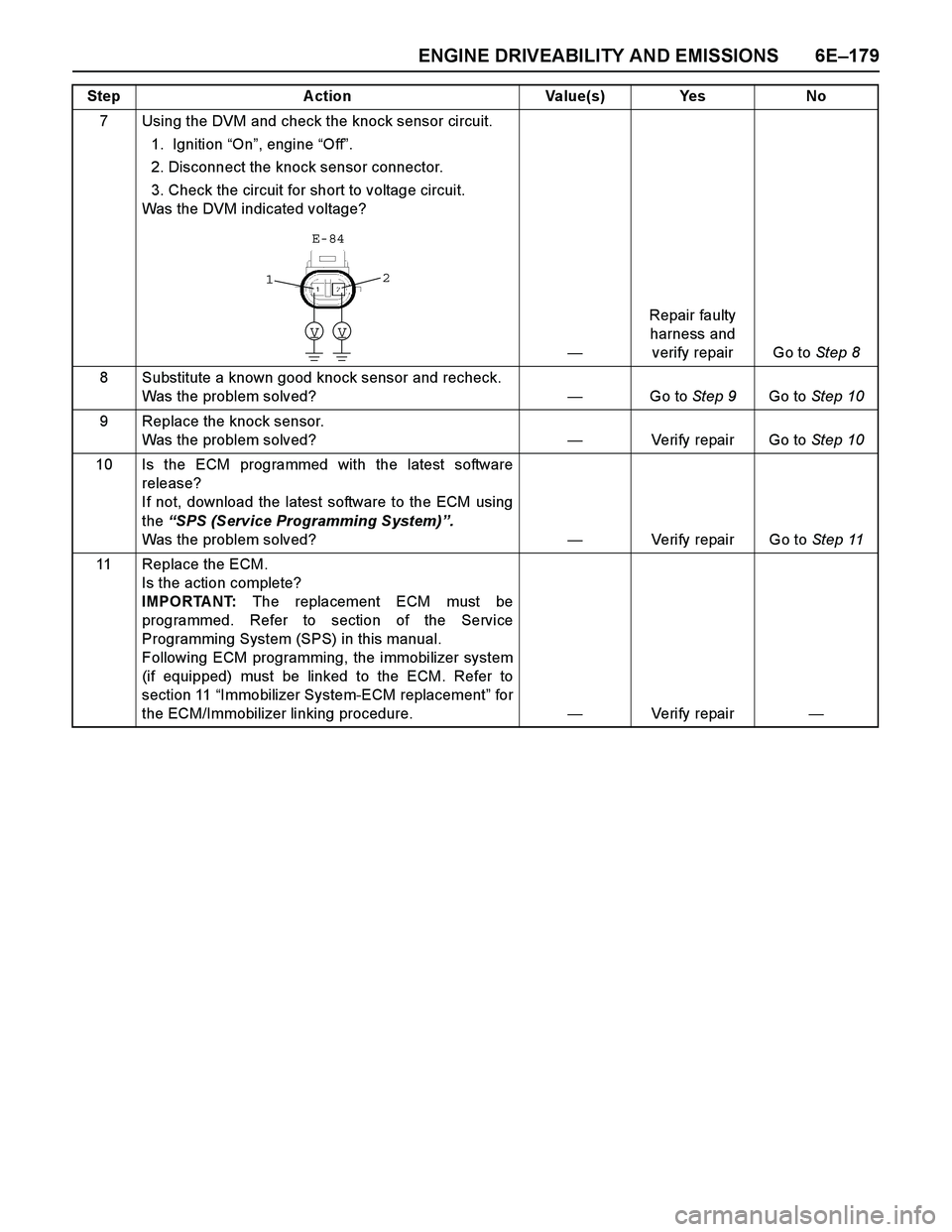
ENGINE DRIVEABILITY AND EMISSIONS 6E–179
7 Using the DVM and check the knock sensor circuit.
1. Ignition “On”, engine “Off”.
2. Disconnect the knock sensor connector.
3. Check the circuit for short to voltage circuit.
Was the DVM indicated voltage?
—Repair faulty
harness and
verify repair Go to Step 8
8 Substitute a known good knock sensor and recheck.
Was the problem solved?—Go to Step 9Go to Step 10
9 Replace the knock sensor.
Was the problem solved?—Verify repair Go to Step 10
10 Is the ECM programmed with the latest software
release?
If not, download the latest software to the ECM using
the “SPS (Service Programming System)”.
Was the problem solved?—Verify repair Go to Step 11
11 Replace the ECM.
Is the action complete?
IMPORTANT: The replacement ECM must be
programmed. Refer to section of the Service
Programming System (SPS) in this manual.
Following ECM programming, the immobilizer system
(if equipped) must be linked to the ECM. Refer to
section 11 “Immobilizer System-ECM replacement” for
the ECM/Immobilizer linking procedure.—Veri fy repai r— Step A ction Value(s) Yes No
VV
E-84
2
1
Page 2757 of 4264
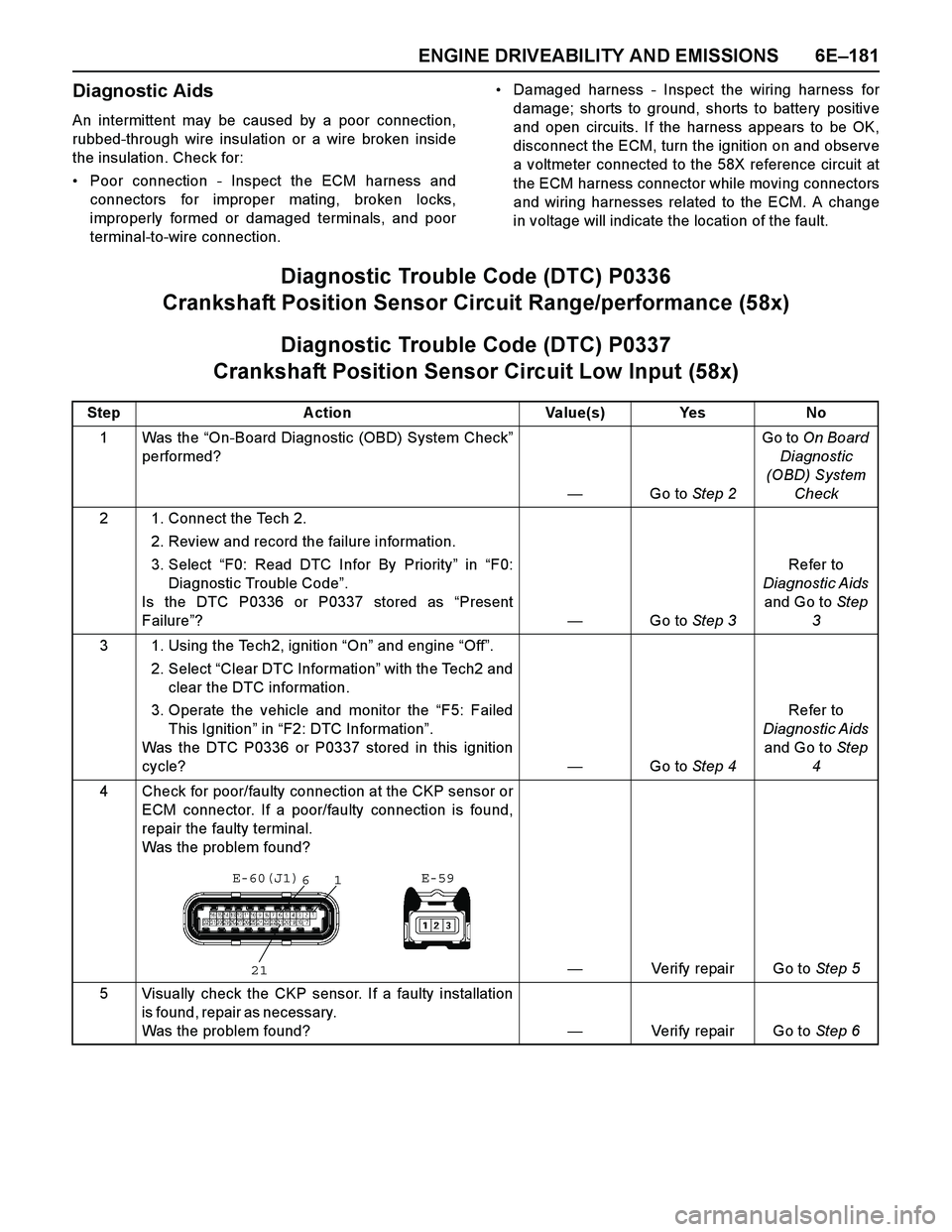
ENGINE DRIVEABILITY AND EMISSIONS 6E–181
Diagnostic Aids
An intermittent may be caused by a poor connection,
rubbed-through wire insulation or a wire broken inside
the insulation. Check for:
Poor connection - Inspect the ECM harness and
connectors for improper mating, broken locks,
improperly formed or damaged terminals, and poor
terminal-to-wire connection.Damaged harness - Inspect the wiring harness for
damage; shorts to ground, shorts to battery positive
and open circuits. If the harness appears to be OK,
disconnect the ECM, turn the ignition on and observe
a voltmeter connected to the 58X reference circuit at
the ECM harness connector while moving connectors
and wiring harnesses related to the ECM. A change
in voltage will indicate the location of the fault.
Diagnostic Trouble Code (DTC) P0336
Crankshaft Position Sensor Circuit Range/performance (58x)
Diagnostic Trouble Code (DTC) P0337
Crankshaft Position Sensor Circuit Low Input (58x)
Step A ction Value(s) Yes No
1 Was the “On-Board Diagnostic (OBD) System Check”
performed?
—Go to Step 2Go to On Board
Diagnostic
(OBD) System
Check
2 1. Connect the Tech 2.
2. Review and record the failure information.
3. Select “F0: Read DTC Infor By Priority” in “F0:
Diagnostic Trouble Code”.
Is the DTC P0336 or P0337 stored as “Present
Failure”?—Go to Step 3Refer to
Diagnostic Aids
and Go to Step
3
3 1. Using the Tech2, ignition “On” and engine “Off”.
2. Select “Clear DTC Information” with the Tech2 and
clear the DTC information.
3. Operate the vehicle and monitor the “F5: Failed
This Ignition” in “F2: DTC Information”.
Was the DTC P0336 or P0337 stored in this ignition
cycle?—Go to Step 4Refer to
Diagnostic Aids
and Go to Step
4
4 Check for poor/faulty connection at the CKP sensor or
ECM connector. If a poor/faulty connection is found,
repair the faulty terminal.
Was the problem found?
—Verify repair Go to Step 5
5 Visually check the CKP sensor. If a faulty installation
is found, repair as necessary.
Was the problem found? —Verify repair Go to Step 6
21
61 E-60(J1) E-59
Page 2758 of 4264
6E–182 ENGINE DRIVEABILITY AND EMISSIONS
6 Using the DVM and check the CKP sensor circuit.
Breaker box is available:
1. Ignition “Off”, engine “Off”.
2. Install the breaker box as type A. (ECM
disconnected) Refer to 6E-88 page.
3. Check the resistance of the CKP sensor.
Was the DVM indicated specified value?
Breaker box is not available:
1. Ignition “Off”, engine “Off”.
2. Disconnect the ECM connector.
3. 3. Check the resistance of the CKP sensor.
Was the DVM indicated specified value?
Approx imately
0.58k� at
20°CGo to Step 10Go to Step 7
7 Using the DVM and check the CKP sensor circuit.
1. Ignition “Off”, engine “Off”.
2. Disconnect the CKP sensor connector.
3. Check the resistance of the CKP sensor.
Was the DVM indicated specified value?
Approx imately
0.58k� at
20°CGo to Step 8Go to Step 14 Step A ction Value(s) Yes No
J1-6J1-21
�
Breaker Box
6
21E-60(J1)
CKP Sensor
���
��
�
Page 2759 of 4264
ENGINE DRIVEABILITY AND EMISSIONS 6E–183
8 Using the DVM and check the CKP sensor circuit.
Breaker box is available:
1. Ignition “Off”, engine “Off”.
2. Install the breaker box as type A. (ECM
disconnected) Refer to 6E-88 page.
3. Disconnect the CKP sensor connector.
4. Check the circuit for open, short to sensor wire or
short to ground circuit.
Was the problem found?
Breaker box is not available:
1. Ignition “Off”, engine “Off”.
2. Disconnect the ECM connector.
3. Disconnect the CKP sensor connector.
4. Check the circuit for open, short to sensor wire or
short to ground circuit.
Was the problem found?
—Repair faulty
harness and
verify repair Go to Step 9 Step A ction Value(s) Yes No
J1-6J1-21 Breaker Box
E-59
��
�
�
�� ��
�� �
�
6E-60(J1)
21
E-59 E-60(J1)
6
21
2 1
Page 2760 of 4264

6E–184 ENGINE DRIVEABILITY AND EMISSIONS
9 Using the DVM and check the CKP sensor circuit.
1. Ignition “On”, engine “Off”.
2. Disconnect the CKP sensor connector.
3. Check the circuit for short to power supply circuit.
If the DVM indicated out of specified value, repair
faulty harness and verify repair.
Is the action complete?
Less than 1V Verify repair—
10 Using the DVM and check the CKP sensor signal.
1. Ignition “On”, engine “On”.
2. Measure the CKP output voltage at the sensor
and ECM.
Does the tester indicate standard voltage?
If a oscilloscope is available, monitor the CKP sensor
signal. Does the oscilloscope indicate correct wave
form?
Go to Step 13Go to Step 11
11 Remove the CKP sensor from the flywheel housing
and visually check.
Check for the following conditions.
Objects sticking the CKP sensor.
Objects sticking the CKP sensor pulser.
If a problem is found, repair as necessary.
Was the problem found? —Verify repair Go to Step 12
12 Check the CKP sensor shield wire for open or short
circuit.
Was the problem found?—Repair faulty
harness and
verify repair Go to Step 13 Step A ction Value(s) Yes No
VV
E-59
21
Measurement Point Voltage (V) (AC Range)
At CKP sensor terminal 1 & 2 Approx. 3.7V in engine idle
Appro x . 7.8V at 2000rpm
At ECM E60 (J1) connector 21 & 6
Crankshaft Position (CKP) Sensor Reference Wa ve Form
0V
Measurem ent Term ina l: J1-21(+) J1-6(-)
Measurement Scale: 10V/div 5ms/div
Measurement Condition: Approximately 2000rpm
Page 2761 of 4264
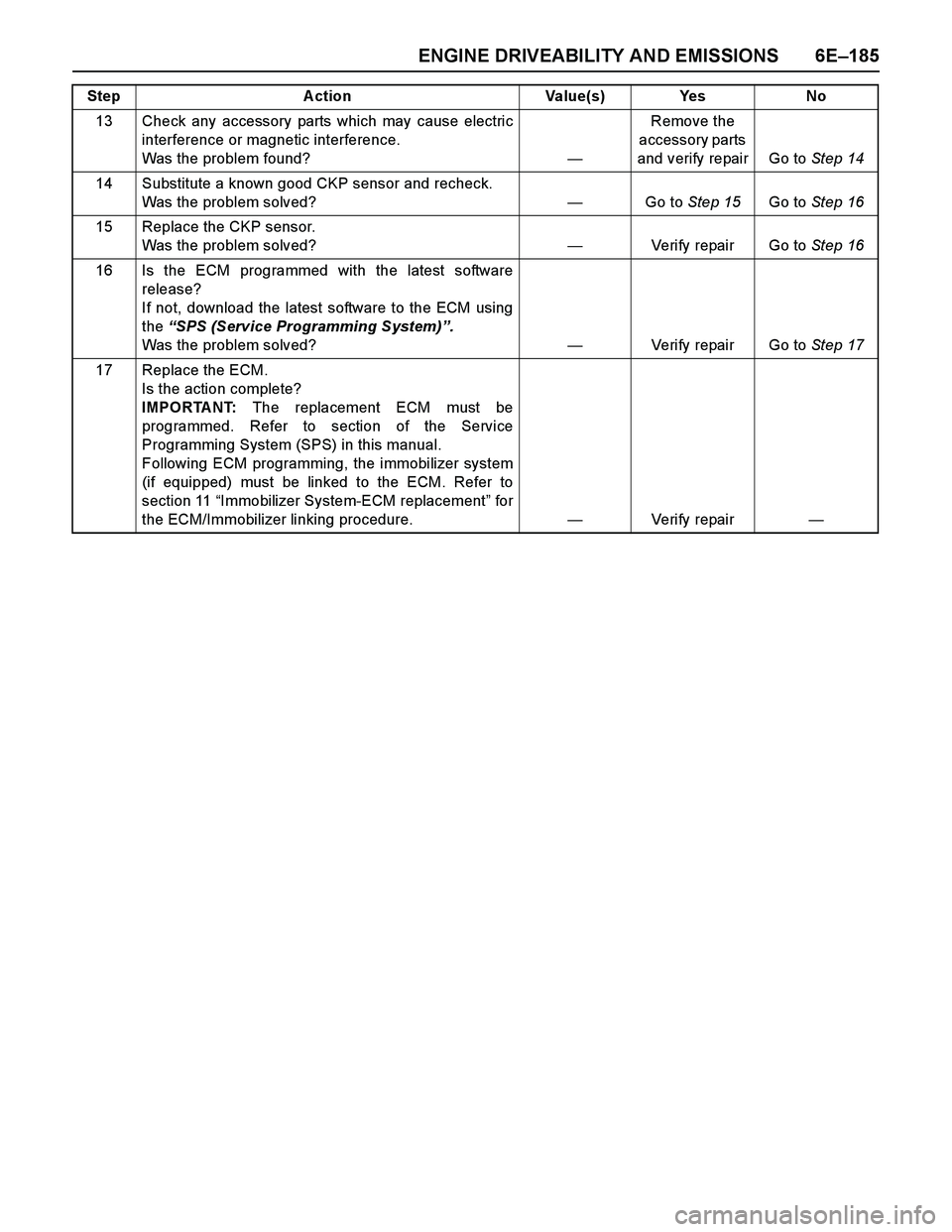
ENGINE DRIVEABILITY AND EMISSIONS 6E–185
13 Check any accessory parts which may cause electric
interference or magnetic interference.
Was the problem found?—Remove the
accessory parts
and verify repair Go to Step 14
14 Substitute a known good CKP sensor and recheck.
Was the problem solved?—Go to Step 15Go to Step 16
15 Replace the CKP sensor.
Was the problem solved?—Verify repair Go to Step 16
16 Is the ECM programmed with the latest software
release?
If not, download the latest software to the ECM using
the “SPS (Service Programming System)”.
Was the problem solved?—Verify repair Go to Step 17
17 Replace the ECM.
Is the action complete?
IMPORTANT: The replacement ECM must be
programmed. Refer to section of the Service
Programming System (SPS) in this manual.
Following ECM programming, the immobilizer system
(if equipped) must be linked to the ECM. Refer to
section 11 “Immobilizer System-ECM replacement” for
the ECM/Immobilizer linking procedure.—Veri fy repai r— Step A ction Value(s) Yes No
Page 2762 of 4264
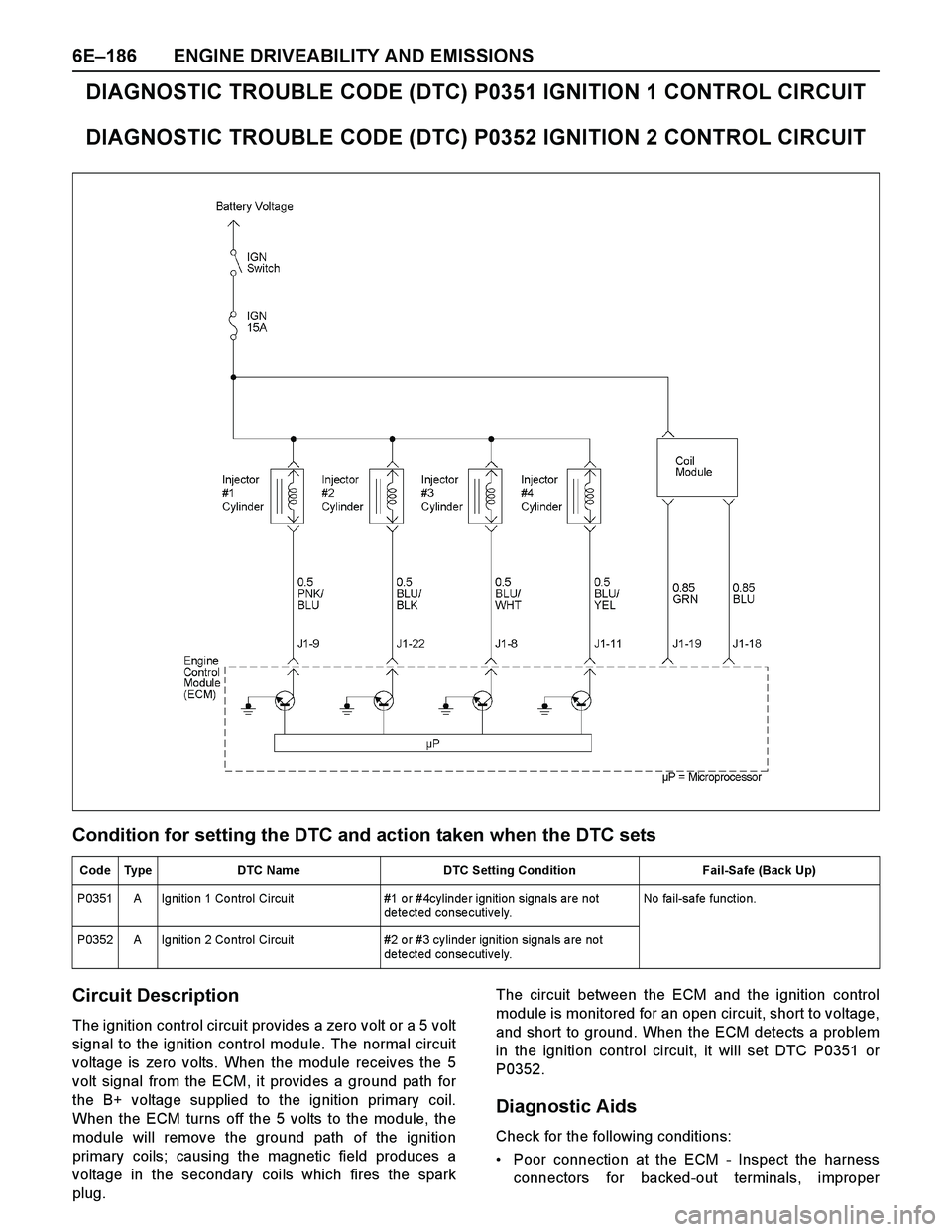
6E–186 ENGINE DRIVEABILITY AND EMISSIONS
DIAGNOSTIC TROUBLE CODE (DTC) P0351 IGNITION 1 CONTROL CIRCUIT
DIAGNOSTIC TROUBLE CODE (DTC) P0352 IGNITION 2 CONTROL CIRCUIT
Condition for setting the DTC and action taken when the DTC sets
Circuit Description
The ignition control circuit provides a zero volt or a 5 volt
signal to the ignition control module. The normal circuit
voltage is zero volts. When the module receives the 5
volt signal from the ECM, it provides a ground path for
the B+ voltage supplied to the ignition primary coil.
When the ECM turns off the 5 volts to the module, the
module will remove the ground path of the ignition
primary coils; causing the magnetic field produces a
voltage in the secondary coils which fires the spark
plug.The circuit between the ECM and the ignition control
module is monitored for an open circuit, short to voltage,
and short to ground. When the ECM detects a problem
in the ignition control circuit, it will set DTC P0351 or
P0352.
Diagnostic Aids
Check for the following conditions:
Poor connection at the ECM - Inspect the harness
connectors for backed-out terminals, improper
Code Type DTC Name DTC Setting Condition Fail-Safe (Back Up)
P0351 A Ignition 1 Control Circuit #1 or #4cylinder ignition signals are not
detected consecutively.No fail-safe function.
P0352 A Ignition 2 Control Circuit #2 or #3 cylinder ignition signals are not
detected consecutively.